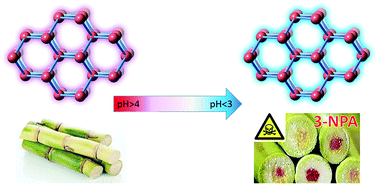A pH-regulated ratiometric luminescence Eu-MOF for rapid detection of toxic mycotoxin in moldy sugarcane†
Abstract
Dual-emitting MOF materials have been widely explored in recent years for their potential applications as ratiometric luminescent probes. However, most of these dichromatic MOFs were constructed through encapsulation of dye molecules, and ones with intrinsic dual-emission from ligands and/or metal ions are still rare. Herein, we report a novel Eu-MOF (1) composed of trinuclear europium clusters and 2,6-naphthalenedicarboxylate (NDC) linkers. It exhibits ratiometric luminescence behavior within a pH range of 4.00 to 3.00. On the basis of an in situ single-crystal to single-crystal transformation study, a mechanism is proposed for this pH-regulated luminescence switching, in which the tiny variations in Eu-O bond lengths disturb the energy transfer from the ligand to the metal and therefore diminish the “antenna effect”. Specifically, the Eu–ONDC bond length is elongated and the Eu–Owater bond length is shortened with increasing acidity, resulting in a gradually reduced luminescence intensity of Eu3+ and gradually enhanced luminescence intensity of the NDC ligand at the same time. This unique luminescence switching property of 1 allows for quantitative detection of 3-nitropropionic acid (3-NPA), a toxic mycotoxin in moldy sugarcane. Moreover, a rapid, highly sensitive, and visualizable response to 3-NPA is demonstrated by using MOF-based test paper.



 Please wait while we load your content...
Please wait while we load your content...